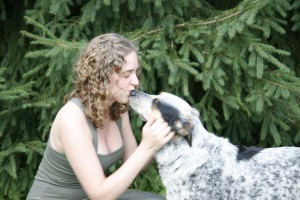 By Amélie Bourdon
By Amélie Bourdon
M.C.P. Specialist in canine behavior at Espace Chien
Member of the APDT Instructor and evaluator for the program “My Dog HAS C.L.A.S.S.”
March 3 2016 – Your dog follows you everywhere in the house. It cannot bear your absence and barks when you leave home. This behavior may result in complaints from the neighbourhood. During your absence, if it is free as a bird in the house, the animal attacks the door or windows.
But if it is in a cage, it turns into a magician, like Houdini, to the point that you have to tie it up with climbing clips, fasteners or a padlock.
This behavior is called canine separation anxiety. It happens when your dog is “hyper attached” to you or to others. Although this problem may be multifactorial, it is often identified with the dogs living with retirees or homeworkers. The animal gets used to their constant presence, so that It becomes anxious when they leave their home.
Causes of Anxiety
This form of distress is due to increased anxiety, which peaked after 30 minutes. The stress is so intense that a dog will do all it can in order to join you. It will come out of its cage and will tackle the different potential outcomes, e.g. the door or windows. It may also seek to reassure itself in chewing objects impregnated with your body odor, for instance the remote control or your shoes. The stress experienced by the animal is accompanied by a sudden urge to defecate, due to an inability to remember. Many owners think the dog retaliates by doing so. But it is not the case.
Do Not Punish Your Animal
In such circumstances, many people have the habit of punishing their animal. This reaction is quite normal. Unfortunately, it only increases stress levels.
Manage the Environment
Before leaving your residence, leave the lights on, as well as radio or television. It helps to ease the feeling of emptiness and silence when you are not there. And thirty minutes before leaving your home, do not give more attention to your pet. Don’t talk to it, don’t touch it, don’t look at it. Act as if it is not there.
You can coat a toy with frozen peanut butter, then give it to your dog. It will occupy it and change its ideas in your absence. On your return, go on doing the same thing you did when you left home: ignore it for 30 minutes. If it defecates, do not clean it up right away.
A Specialist to the Rescue
For dogs whose separation anxiety is of low intensity, the environmental management is often sufficient to solve the problem. In more complex cases, ask the help of a specialist in canine behavior. Make sure you choose someone who is trained in this area and does not advocate a repressive approach like a choke collar, an electric shock collar or citronella collar.
These methods can improve short-term situation, but will only get worse in the long run. To eradicate more effectively separation anxiety, an expert in canine behavior should work with your veterinarian. In so doing, you will get a much more effective support in achieving this goal.
Do not get discouraged. Be persistent. Over time, separation anxiety will fade away and your dog will stop its unpleasant behavior.
All Rights Reserved
Like this article? Like us on Facebook.
Photo 2: Dollar Photo Club/Brebca
You may also watch ou videos that are subtitled in English.
Click on the icon on the right hand side:
Balinese Cats/Zootherapy and autism/Advertising Video of Realité Animale


